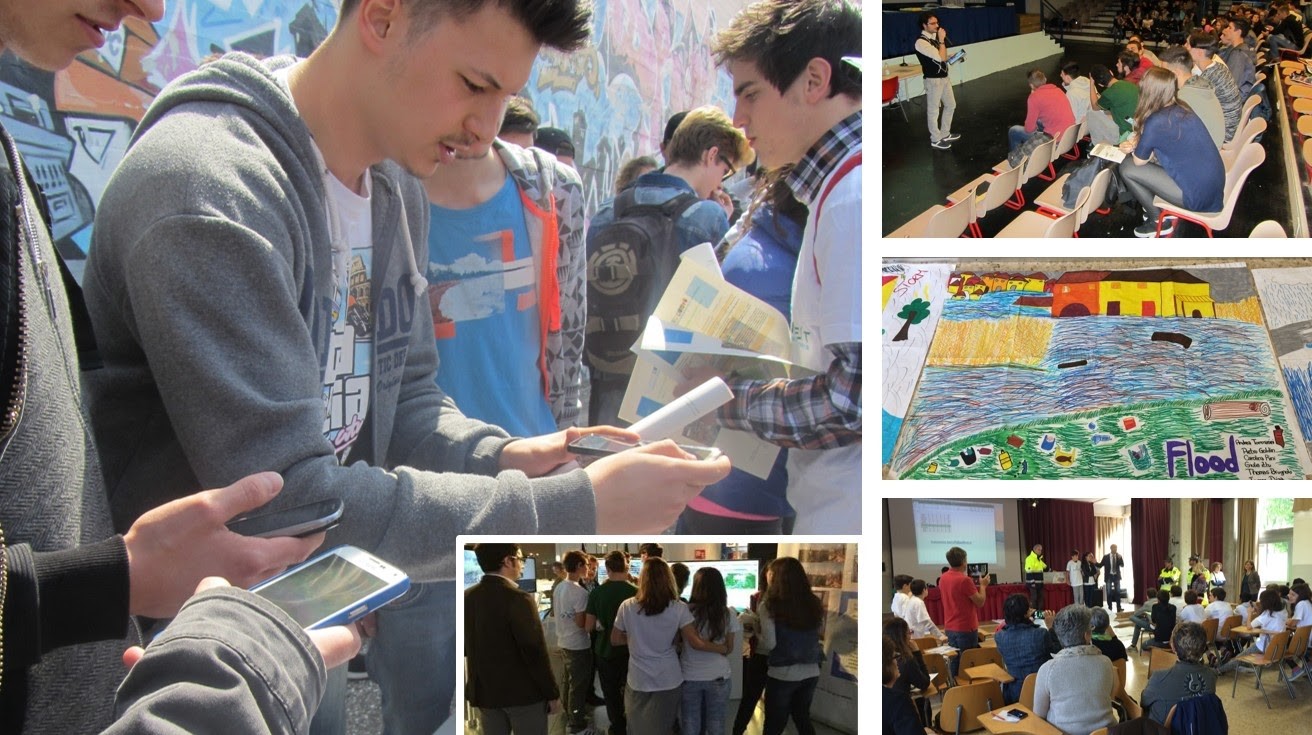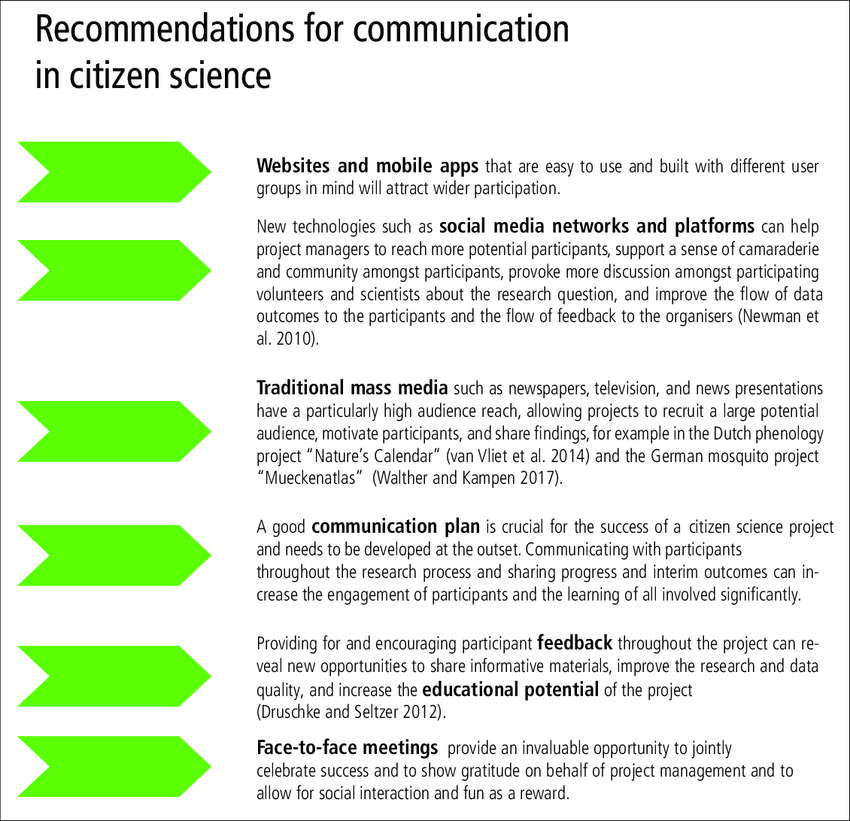In the specific case of a Citizen Observatory, you will want to spend some time thinking about what types of impact you are aiming for; what information, data and results will be needed to achieve those impacts; and therefore what types of communication will be most appropriate. For example, is your aim to provide policy-makers with data that will inform the development of new policies or regulations? If so, you will want to spend some time working with them to understand their information needs: what format should that data be presented in, is there a specific moment in time that they will need to receive this data, and how will they use that data further to bring about the desired impacts? By finding out these needs in advance, you will be able to plan for them from the beginning.
Consider these methodologies from the beginning of the observatory and try to plan what type of dissemination you will use with the citizen community. Plan also to dedicate some resources to this type of activities and to the elaboration of adequate contents. Putting in place mechanisms to collect citizens feedback will help in better focusing and addressing future dissemination activities.
Examples from the Mapping for Change project to measure noise pollution in London’s Pepys Estate
People living in the Pepys Estate in London, England were suffering from noise pollution from a scrapyard near the centre of the estate and very close to both a primary and nursery school, but after more than six years of trying to deal with this problem and raising concerns with the Mayor of Lewisham and others, the disturbance started to escalate.

People living in the Pepys Estate in London, England were suffering from noise pollution from a scrapyard near the centre of the estate and very close to both a primary and nursery school. But after more than six years of trying to deal with this problem and raising concerns with the Mayor of Lewisham and others, the disturbance started to escalate.
With the support of the “Mapping Change for Sustainable Communities” project run by the London 21 sustainability network and a research group within the University College London (which later spun out into the Social Enterprise Mapping for Change), members of the community used noise meters to make over 1500 measurements at all times of day and night and developed their own ‘noise maps’. Armed with this information, the community initiative called a public meeting to present their findings to the Council and the Environment Agency.
Recognising from the robust data that there was a real and tangible problem, Lewisham Council and the Environment Agency appointed an acoustic consultant to carry out a detailed analysis of noise in and from the scrapyard. This resulted in the license of the scrapyard being revoked.
- A description of the impact of this noise mapping approach and other community mapping initiatives of Mapping for Change can be found here.
- The Citizen Observatory initiative described above was followed up with an investigation of local air quality by the same community of residents. The ‘data stories’ gathered in that initiative as part of the Urban Sensing Citizen Observatory, and other stories from parallel initiatives, are described in this report on the Citizen Sense website.
The concept of ‘just good enough’ data for decision-making purposes is explored further in this paper by Jennifer Gabrys and Helen Pritchard: “Just Good Enough Data and Environmental Sensing: Moving Beyond Regulatory Benchmarks toward Citizen Action”.
Example from the Citizen Observatory of Water for flood risk management in the Brenta-Bacchiglione catchment, Italy
The Citizen Observatory of Water implemented in the Brenta-Bacchiglione catchment started as a pilot for the WeSenseIt project, with the aim to increase the resilience of the local communities during floods.

Since having demonstrated its value in addressing residual flood risk, it has been promoted via local and national media at the national and European levels as an example of awareness-raising and active public involvement in water management policy, strengthening communication channels before and during flood events.
This resulted in the inclusion in the non-structural mitigation measures of the Flood Risk Management Plan of the Eastern Alps Hydrographic District and in the financing of the measure by the Italian Ministry of Environment.
An important part of the success of the initiative is the communication plan, which will continue over the next five years. In addition to communication through the Citizen Observatory website and via social media campaigns, radio broadcasts and regional newspapers, the plan also includes the development of educational programmes for teachers and students within the 120 municipalities currently located in high-flood-risk zones in the Brenta-Bachiglione catchment area.
The education campaigns help to increase student awareness of existing flood risks in their own area and to help them recognise the value of the Citizen Observatory in protecting their families. Through this they learn that by providing important information about flooding, they can contribute to everyone’s safety.
Example from the WeObserve project
Knowledge collected from Citizen Observatories, the WeObserve Communities of Practice and the other related initiatives has been consolidated in the WeObserve project in two policy briefs with recommendations for policy-makers on how to foster Citizen Observatories to address environmental challenges. The first policy brief, entitled “A Roadmap for Citizen Science in GEO – The essence of the Lisbon Declaration”, aims to secure the integration of Citizen Science and Citizen Observatories into the Global Earth Observation System of Systems (GEOSS). This policy brief summarises three key messages from the Lisbon Declaration for European policy-makers and describes how best to connect and integrate Citizen Science communities as well as their activities and outputs into GEO. The second policy brief, entitled “Mission Sustainable: Fostering an enabling environment for sustainable Citizen Observatories”, provides recommendations that can contribute to the generation, execution and sustainability of Citizen Observatories. Based on a range of inputs from practitioners, the policy brief makes four specific recommendations to European and national funding bodies and policy-makers for fostering an enabling environment that can contribute to the generation, execution and sustainability of Citizen Observatories, thereby maximising their impact.
![]()



